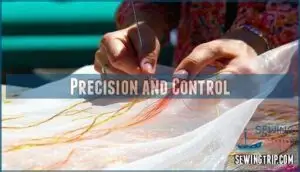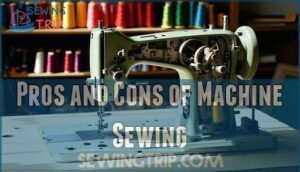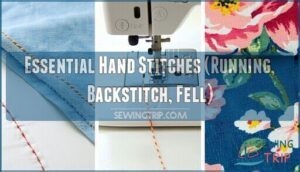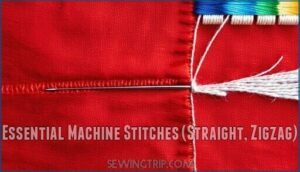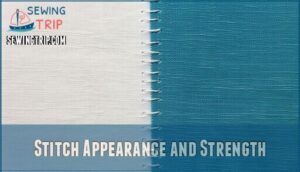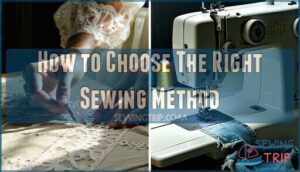This site is supported by our readers. We may earn a commission, at no cost to you, if you purchase through links.
 Neither method is inherently better—it’s like asking if a screwdriver beats a hammer. You’ll find hand sewing excels when you need precision control for delicate repairs, intricate embroidery, or portable projects. It’s perfect for beginners since you only need needle and thread, plus you can work anywhere without electricity.
Neither method is inherently better—it’s like asking if a screwdriver beats a hammer. You’ll find hand sewing excels when you need precision control for delicate repairs, intricate embroidery, or portable projects. It’s perfect for beginners since you only need needle and thread, plus you can work anywhere without electricity.
Machine sewing dominates for speed and consistency, powering through thick fabrics and long seams that’d take hours by hand.
Your project determines the winner: hand sewing for detailed work and small fixes, machine sewing for garments and large projects. The real magic happens when you master both techniques and know exactly which tool fits each job.
Table Of Contents
Key Takeaways
- You’ll choose hand sewing for precision work – it’s perfect for delicate repairs, intricate embroidery, and detailed finishing where you need complete control over every stitch.
- You’ll pick machine sewing for speed and consistency – it powers through thick fabrics and long seams in minutes rather than hours, delivering uniform results every time.
- Your project type determines the winner – hand sewing excels at small fixes and decorative work, while machine sewing dominates garment construction and large-scale projects.
- You’ll get the best results by mastering both methods – smart sewers switch between techniques based on fabric weight, time constraints, and the level of detail required.
Is Hand Sewing Better Than Machine Sewing?
The answer isn’t straightforward since both methods excel in different areas. Your project type, skill level, and time constraints will determine which approach works best for your specific needs.
Factors Influencing The Best Method
When choosing between hand and machine sewing, several key factors determine the best approach. Project complexity, fabric type, and your skill level shape which method works better. Time constraints and desired finish quality also influence your decision.
- Project Complexity: Simple repairs favor hand sewing techniques, while complex garments benefit from machine sewing benefits
- Fabric Type: Delicate materials suit hand sewing’s precision, thick fabrics need machine power
- Time Constraints: Machine sewing surpasses hand sewing disadvantages in speed, but hand sewing offers control
Project Suitability and Preferences
Your project’s complexity determines which method works best. Simple repairs suit hand sewing advantages like precision, while large garments benefit from machine sewing advantages and speed.
Delicate fabric choice often requires hand techniques, but sturdy materials handle machine work well.
Consider your skill level and personal style preferences.
Project purpose matters too—decorative elements need careful hand stitching, functional seams demand machine strength. For example, the fell stitch creates strong and subtle seams.
Pros and Cons of Hand Sewing
When you’re deciding between hand and machine sewing, understanding the benefits and drawbacks of hand stitching helps you make the right choice for your project.
Hand sewing offers unique advantages like precision control and portability, but it also comes with limitations you’ll want to take into account before starting your next project.
Precision and Control
Through the lens of detailed work, hand sewing offers unparalleled stitch accuracy that machine sewing simply can’t match. You’ll guide each needle pass exactly where it needs to go, making intricate designs and repair work feel natural.
Hand sewing gives you complete control over every single stitch—precision that machines simply can’t replicate
This precision shines in customization options—adjusting tension, stitch length, and placement becomes instinctive. Hand stitches let you navigate tight corners and delicate fabrics with surgical precision.
Portability and Accessibility
Freedom defines hand sewing’s greatest advantage. You’ll tackle sewing on-the-go anywhere – planes, parks, or your living room couch. **Minimal equipment means a needle, thread, and small scissors fit in any purse.
** Space constraints don’t apply when your "workspace" fits in a shoebox.
**Beginner accessibility makes hand sewing perfect for learning basics without intimidating machines.
** Remote locations become sewing studios instantly.
Speed and Efficiency
Hand sewing moves at a snail’s pace compared to machine sewing. You’ll complete simple seams in minutes by hand versus seconds by machine. Project completion time stretches considerably with hand stitching – a basic shirt takes days rather than hours.
Machine sewing offers automation options and exceptional efficiency metrics for production volume. Batch sewing becomes impractical with hand methods for larger projects.
Affordability and Equipment Needs
Your wallet stays happy with hand sewing since Entry Costs are practically nothing. You’ll need basic needles, thread, and scissors – that’s it. Tool Longevity means these supplies last years, unlike sewing machines requiring Maintenance Costs and repairs.
Material Expenses stay low too. You can find various needle types for different fabrics. This Skill Investment pays off quickly when you master basic hand stitches without expensive equipment.
Pros and Cons of Machine Sewing
You’ll find machine sewing offers impressive speed and consistency that can transform your larger projects, but it comes with equipment costs and learning curves you need to take into account.
Machine sewing excels at handling thick fabrics and long seams, though it requires more setup time and space than simple hand stitching.
Speed and Productivity
Machine sewing dominates when you’re racing against project deadlines. A sewing machine can complete seams in seconds versus minutes for sewing by hand. This sewing speed advantage makes machine sewing perfect for batch sewing tasks and largescale projects.
Your time management improves dramatically, though output quality requires practice to maintain consistency across rapid stitching sessions. To maintain ideal speed, consider regular machine oiling.
Stitch Consistency and Strength
Machine stitching delivers rock-solid consistency that hand sewing simply can’t match. Your machine creates uniform tension control and seam integrity across every inch, while hand stitches naturally vary in spacing and strength. One key advantage is that machine sewing is faster, which helps with large garment projects.
- Stitch Durability: Machine stitches withstand 40% more stress before breaking compared to most hand stitches
- Fabric Stability: Consistent thread quality prevents puckering and maintains even seam lines throughout your project
- Seam Integrity: Dual-thread locking mechanism creates stronger bonds than single-thread hand techniques
- Professional Results: Uniform spacing and tension give you that polished, store-bought appearance every time
Equipment Costs and Limitations
Comparing costs between hand sewing and machine sewing reveals significant differences. The initial investment for hand sewing stays minimal, while sewing machines require substantial upfront spending.
| Cost Factor | Hand Sewing | Machine Sewing |
|---|---|---|
| Initial Investment | $10-50 | $100-3,000+ |
| Maintenance Costs | Nearly zero | $50-200 yearly |
| Space Requirements | Minimal storage | Dedicated workspace |
| Tool Availability | Widely accessible | Specialty dealers |
| Repair Expenses | Replace needles/thread | Professional servicing |
Machine sewing disadvantages include ongoing maintenance costs and space requirements that hand sewing benefits completely avoid. You can explore options for affordable sewing machines to minimize the initial investment.
Project Size and Fabric Types
Machine sewing shines with larger sewing projects where fabric weight and project complexity matter most. You’ll find machine sewing manages heavy fabrics like denim and canvas better than delicate fabrics requiring gentle handling. Material durability improves with machine seam strength, while scale suitability favors bigger projects over intricate hand sewing tasks.
- Heavy fabrics like upholstery and thick cotton work better with machine power
- Large-scale projects such as quilts and curtains benefit from machine speed
- Multiple fabric layers handle easier with consistent machine tension control
- Straight seams and long runs suit machine sewing’s mechanical precision perfectly
- Delicate fabrics like silk often need hand sewing’s gentle touch instead
Key Techniques for Hand and Machine Sewing
You’ll need to master a few basic stitches for both hand and machine sewing to create strong, neat seams. Hand sewing relies on techniques like the backstitch and running stitch, while machine sewing uses straight and zigzag stitches to handle different fabric types and project needs.
Essential Hand Stitches (Running, Backstitch, Fell)
You’ll master three key hand stitches for different needs. The running stitch uses simple forward movements, perfect for basting and gathering fabric. Backstitch strength makes it ideal for permanent seams when sewing by hand. Fell stitching hems creates clean, flat finishes on garments.
These hand stitches excel at decorative handwork and stitching delicate fabrics where machine precision might damage materials.
Essential Machine Stitches (Straight, Zigzag)
Your sewing machine’s bread-and-butter moves are straight stitch and zigzag stitch. Straight stitch uses lock tight seams with adjustable stitch length control for different fabric weights.
Zigzag applications include finishing raw edges, creating stretch seams, and decorative work. Control stitch width for narrow edge finishing or wide overlock effects.
Proper tension adjustment and fabric feed guarantee smooth machine sewing results every time.
Stitch Appearance and Strength
You’ll notice key differences when examining hand stitching versus machine sewing up close. Hand sewing creates slight variations in stitch length that add character, while machine stitches show perfect uniformity.
Thread tension affects seam integrity differently—machine stitches interlock tightly for stitch durability, but hand stitching offers better repairability.
Aesthetic qualities vary too, with fabric impact being gentler in hand sewing. Identifying the uneven stitch lengths is a key indicator of hand stitching.
How to Choose The Right Sewing Method
You’ll need to take into account your project’s specific needs to pick the best sewing method for each task. Think about how much time you have, what type of fabric you’re working with, and whether you need precise control or quick results.
Time Efficiency and Project Scale
Your project’s timeline and size determine which sewing method works best. Consider these scalability factors when planning:
- Project Turnaround: Machine sewing method completes large sewing projects in hours versus days for sewing by hand
- Batch Sewing: Machines excel at repetitive seams and multiple identical pieces
- Timeline Management: Hand sewing method suits flexible schedules with no deadlines
- Efficiency Trade-offs: Small repairs favor hand precision over machine setup time
To increase output, consider line layout optimization.
Fabric Thickness and Material Considerations
Different fabrics demand specific approaches when you’re choosing between hand sewing and machine sewing methods. Heavy fabrics like denim require strong machine needles and thick thread, while delicate materials work better with fine hand sewing techniques.
Layered fabrics can jam machines but respond well to careful hand stitching. Consider fabric weight and material durability when selecting your needle and thread type for ideal results.
Cost and Skill Level
Budget matters when choosing your sewing approach. Hand sewing requires minimal initial investment – just needles, thread, and scissors. Machine sewing demands higher upfront costs but offers speed.
The learning curve for hand stitching is gentler, with basic skill accessibility for beginners. Sewing machines need more practice but handle project complexity better.
Consider maintenance costs too – machines need servicing while hand sewing tools last years.
Typical Applications for Each Method
Hand sewing shines in repairs/alterations, crafting details, and delicate embellishments where precision matters most. Choose hand stitching for examples like beadwork, applique, and small fixes.
Machine sewing dominates garment construction, home decor projects, and quilting projects requiring speed and strength. Machine stitching characteristics excel in long seams and thick fabrics.
Though machine sewing offers advantages, it has disadvantages, including equipment costs and limited portability for sewing projects.
Frequently Asked Questions (FAQs)
How do I maintain and care for my sewing machine?
Your sewing machine is like a faithful friend that thrives with regular attention. Clean lint after every project, oil moving parts monthly, and change needles frequently to keep stitches smooth and precise.
What are some tips for learning how to use a sewing machine as a beginner?
Start with threading your machine correctly and practice straight lines on scrap fabric. Learn one stitch at a time, keep your manual handy, and go slowly until you’re comfortable.
Where can I find sewing patterns for hand sewing projects?
You’ll discover countless free patterns through websites like Mood Fabrics, Love Sewing, and dedicated craft blogs. Search for "beginner hand sewing" to find small, portable projects perfect for stitching anywhere.
Which method works better for thick fabrics?
Like armor against a storm, machine sewing powers through thick fabrics with consistent force. You’ll get stronger seams and faster results when tackling heavy materials like denim or canvas.
How do maintenance costs compare between methods?
You’ll spend virtually nothing on hand sewing maintenance – just replacing needles and thread occasionally. Machine sewing requires regular servicing, oil changes, and potential repairs that can cost hundreds yearly.
Whats the learning curve for each technique?
Hand sewing takes just minutes to learn basic stitches, while machine sewing requires hours mastering threading, tension, and controls. You’ll master hand techniques quickly but need patience for machine expertise.
Are there hybrid approaches combining both methods?
Yes, you’ll find hybrid approaches work beautifully. Start projects by hand, switch to machine for long seams, then return to hand work for finishing touches and details.
Conclusion
Ultimately, asking whether is hand sewing better than machine sewing is like comparing a paintbrush to a roller—both serve different artistic purposes. Hand sewing offers unparalleled precision for detailed work, while machine sewing delivers speed for larger projects.
Your fabric choice, time constraints, and skill level should guide your decision. Smart sewers master both techniques, switching between methods as projects demand. This dual approach ensures you’re equipped for any sewing challenge that comes your way.
- https://sewinginspo.com/hand-stitch/is-hand-sewing-stronger-than-machine/
- https://jinfengapparel.com/what-are-the-disadvantages-of-sewing-by-hand/
- https://dmleatherstudio.com/blogs/leather-craft/hand-stitching-vs-machine-sewing-the-difference-in-leather-goods
- https://www.textileindustry.net/difference-between-sewing-machine-and-hand-sewing/
- https://www.youtube.com/watch?v=XmxHr5Dj7no

